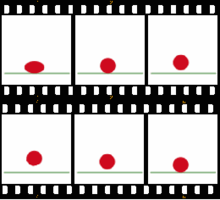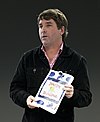Portal:Animation

| Main | Categories and topics | Tasks and projects |
Introduction
Animation is a filmmaking technique by which still images are manipulated to create moving images. In traditional animation, images are drawn or painted by hand on transparent celluloid sheets (cels) to be photographed and exhibited on film. Animation has been recognized as an artistic medium, specifically within the entertainment industry. Many animations are computer animations made with computer-generated imagery (CGI). Stop motion animation, in particular claymation, has continued to exist alongside these other forms.
Animation is contrasted with live-action film, although the two do not exist in isolation. Many moviemakers have produced films that are a hybrid of the two. As CGI increasingly approximates photographic imagery, filmmakers can easily composite 3D animations into their film rather than using practical effects for showy visual effects (VFX). (Full article...)
Selected article
Blue's Clues is an American children's television show that premiered on September 8, 1996, on the cable television network Nickelodeon, and ran for a decade, until August 6, 2006. Producers Angela Santomero, Todd Kessler, and Traci Paige Johnson combined concepts from child development and early-childhood education with innovative animation and production techniques that helped their viewers learn. It was hosted originally by Steve Burns, who although a crucial factor in its success, left in 2002 to pursue a music career, and was replaced by Donovan Patton. The show follows an animated blue-spotted dog named Blue as she plays a game with the host and the viewers. They used research about child development and young children's viewing habits that had been conducted in the thirty years since the debut of Sesame Street in the U.S., and revolutionized the genre by inviting their viewers' involvement. Research was part of the creative and decision-making process in the production of the show, and was integrated into all aspects and stages of the creative process. By 2002, Blue's Clues had received several awards for excellence in children's programming, educational software, and licensing, and had been nominated for nine Emmy Awards. Versions of the show have been produced in other countries, and it has been syndicated in 120 countries and translated into 15 languages. It was one of the first preschool shows to incorporate American Sign Language into its content.
Selected image
Did you know (auto-generated) -

- ... that the Tuca & Bertie episode "The Jelly Lakes" employs a paper-cutout animation that helps to depict abuse in a way that centers the victim's story?
- ... that the creators of the cartoon Jade Armor filmed live-action martial arts stunts to visualize the show's animated action sequences?
- ... that the French animated film The Summit of the Gods is based on a Japanese manga series?
- ... that, for the animated film Us Again, director and writer Zach Parrish considered a video of an elderly couple dancing to be visceral and ideal inspiration?
- ... that the live-action comedy series Community had a stop motion animated Christmas special?
- ... that the animated film The Exigency took thirteen years to make?
Selected quote
Selected biography
Stephen Hillenburg (1961–2018) was an American cartoonist, animator, and former marine biologist. He is the creator of the Nickelodeon television series SpongeBob SquarePants (1999–), which he has also directed, produced, and written. It has gone on to become one of the longest-running American television series as well as the highest-rated show ever to air on Nickelodeon. Born in Lawton, Oklahoma and raised in Anaheim, California, Hillenburg became fascinated with the ocean as a child and developed an interest in art. He started his professional career in 1984, instructing marine biology, at the Orange County Marine Institute, where he wrote The Intertidal Zone, an informative comic book about tide-pool animals, which he used to educate his students. He was later offered a job on the Nickelodeon animated television series Rocko's Modern Life (1993–1996) after his success with short films The Green Beret and Wormholes (both 1992), which he made while studying animation. Besides his two Emmy Awards and six Annie Awards for SpongeBob SquarePants, Hillenburg has also received other recognition, such as an accolade from Heal the Bay for his efforts on elevating marine life awareness, and the Television Animation Award from the National Cartoonists Society.
Selected list
The Simpsons shorts are a series of 48 one-minute shorts that ran on the variety show The Tracey Ullman Show for three seasons, before the characters spun off into The Simpsons, their own half-hour prime time show. It features the Simpson family, which consists of Homer, Marge, Bart, Lisa, and Maggie. The series was created by Matt Groening, who designed the Simpson family and wrote many of the shorts. The shorts first aired on April 19, 1987 starting with "Good Night". The final short to air was "TV Simpsons", originally airing on May 14, 1989. The Simpsons later debuted on December 17, 1989 with the Christmas special "Simpsons Roasting on an Open Fire". Only a few of these shorts have been released on DVD. "Good Night" was included on The Simpsons Season 1 DVD. Five of these shorts were later used in the clip show episode "The Simpsons 138th Episode Spectacular" on the half-hour show, which was released on the Season 7 DVD. These five shorts were "Good Night", which was featured in its entirety, and portions of "The Perfect Crime", "Space Patrol", "World War III", and "Bathtime". In "You Kent Always Say What You Want", the short "Family Portrait" replaces the entire opening sequence in celebration of the 400th episode. Groening has announced that all of the shorts will be available on mobile phones.
More did you know...
- ...that Joan of Arc and Mahatma Gandhi were protagonists in Clone High?
- ...that Groundskeeper Willie, a character on The Simpsons, coined the phrase cheese-eating surrender monkeys?
- ...that Superman stops a mad scientist and his army of robots in the 1941 animated short film The Mechanical Monsters?
Anniversaries for May 29
- Films released
- 1937 – Modern Inventions (United States)
- Television series and specials
- 1982 – Ohayō! Spank, a Japanese anime series finishes airing on ABC
- 2004 – Justice League, an American animated series based on the DC Comics superhero Justice League finishes airing on Cartoon Network
- 2008 – Out of Jimmy's Head, an American live-action/animated television series finishes airing on Cartoon Network
- Births
- 1991 – Saori Hayami, Japanese voice actress and singer
Subportals
Related portals
Wikimedia
The following Wikimedia Foundation sister projects provide more on this subject:
-
Commons
Free media repository -
Wikibooks
Free textbooks and manuals -
Wikidata
Free knowledge base -
Wikinews
Free-content news -
Wikiquote
Collection of quotations -
Wikisource
Free-content library -
Wikiversity
Free learning tools -
Wiktionary
Dictionary and thesaurus
























